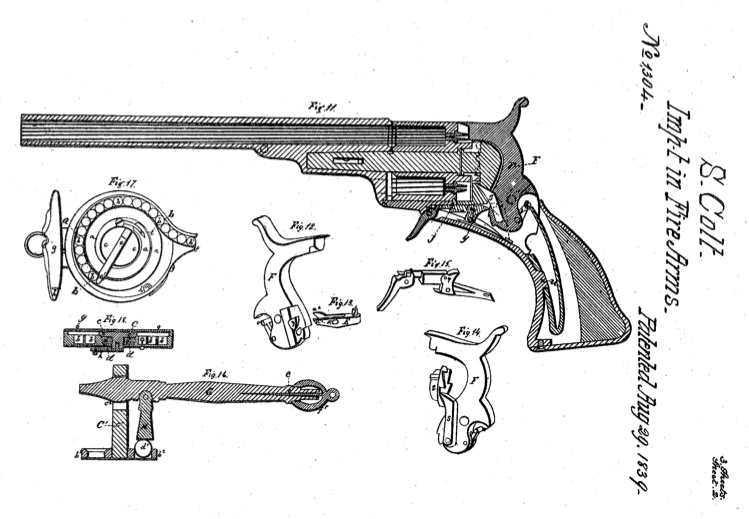Biography of Samuel Colt,(July 19, 1814–January 10, 1862) was an American inventor, industrialist, and entrepreneur best remembered for perfecting a revolving cylinder mechanism that enabled a gun to be fired multiple times without reloading. Later versions of his legendary Colt revolver pistol, first patented in 1836, played a key role in settling the American West. By advancing the use of interchangeable parts and assembly lines, Colt became one of the wealthiest industrialists of the 19th century.
Fast Facts: Samuel Colt
- Known For: Perfected the Colt revolver pistol, one of the legendary firearms said to have “won the West”
- Born: July 19, 1814 in Hartford, Connecticut
- Parents: Christopher Colt and Sarah Caldwell Colt
- Died: January 10, 1862 in Hartford, Connecticut
- Education: Attended Amherst Academy in Amherst, Massachusetts
- Patents: US Patent: 9,430X: Revolving Gun
- Spouses: Elizabeth Hart Jarvis
- Children: Caldwell Hart Colt
Early Life
Samuel Colt was born on July 19, 1814, in Hartford, Connecticut, to businessman Christopher Colt and Sarah Caldwell Colt. One of young Colt’s earliest and most-prized possessions was a flintlock pistol that had belonged to his maternal grandfather, who had served as an officer in Gen. George Washington’s Continental Army during the American Revolution. At age 11, Colt was sent to Glastonbury, Connecticut, to live and work on the farm of a family friend. While attending grade school in Glastonbury, Colt became fascinated with the “Compendium of Knowledge,” an early encyclopedia. Articles he read on steamboat inventor Robert Fulton and gunpowder would inspire him throughout his life.
:max_bytes(150000):strip_icc():format(webp)/samuel-colt-2668193-ce21608b9d384f97b0b1480fdabf5bfb.jpg)
During 1829, the 15-year-old Colt worked in his father’s textiles processing plant in Ware, Massachusetts, where he honed his skills in the use of machine tools and manufacturing processes. In his spare time, he experimented with gunpowder charges, setting off small explosions on nearby Ware Lake. In 1830, Colt’s father sent him to the private Amherst Academy in Amherst, Massachusetts. Though reportedly a good student, he was often disciplined for conducting unapproved demonstrations of his explosive devices. After one such display at the school’s 1830 July 4th celebration caused a fire on campus, Amherst expelled him and his father sent him off to learn the seaman’s trade.
From Sailor to Firearms Legend
By the fall of 1830, the 16-year-old Colt was working as an apprentice seaman on the brig Corvo. From studying how the ship’s wheel and capstan worked, he conceived of how a similarly rotating cylinder could be used to load individual cartridges in front of a gun’s firing barrel. Based on his idea, he began carving wooden models of the gun of his dreams. As Colt would later recall, “regardless of which way the wheel was spun, each spoke always came in direct line with a clutch that could be set to hold it. The revolver was conceived!”
When he returned to Massachusetts in 1832, Colt showed his carved model guns to his father, who agreed to finance the production of two pistols and one rifle based on the design. While the prototype rifle worked well, one of the pistols exploded and the other failed to fire. Though Colt blamed the failures on shoddy workmanship and cheap materials, his father withdrew his financial support. To earn money to pay for more professionally-built guns, Colt began touring the country giving public demonstrations of the new medical marvel of the day, nitrous oxide—laughing gas. It was through these often-outlandishly dramatic displays that Colt developed his skills as a gifted Madison Avenue-style pitchman.
Colt’s Famed Revolvers
With the money he had saved from his “medicine man” days, Colt was able to have prototype guns built by professional gunsmiths. Instead of multiple individually-loaded rotating barrels used in early repeating firearms, Colt’s revolver used a single fixed barrel attached to a rotating cylinder holding six cartridges. The action of cocking the gun’s hammer rotated the cylinder to align the next cartridge to be fired with the gun’s barrel. Rather than claiming to have invented the revolver, Colt always acknowledged that his gun had been an improvement to a revolving flintlock pistol patented by Boston gunsmith Elisha Collier around 1814.
:max_bytes(150000):strip_icc():format(webp)/GettyImages-463917563-75cc7499b81e411898319302fb850497.jpg)
With the help of master gunsmith John Pearson, Colt continued to refine and improve his revolver. After receiving an English patent in 1835, the U.S. Patent Office granted Samuel Colt US patent 9430X for a “Revolving Gun” on February 25, 1836. Along with a group of influential investors including U.S. Patent Office superintendent Henry Ellsworth, Colt opened the Patent Arms Manufacturing Company in Paterson, New Jersey to produce his revolver.
In manufacturing his guns, Colt further advanced the use of interchangeable parts introduced around 1800 by cotton gin inventor Eli Whitney. As he had envisioned, Colt’s guns were built on an assembly line. In an 1836 letter to his father, Colt said of the process, “The first workman would receive two or three of the most important parts and would affix these and pass them on to the next who would add a part and pass the growing article on to another who would do the same, and so on until the complete arm is put together.”
:max_bytes(150000):strip_icc():format(webp)/3colts-b3686002458b439cba58f8aa7cfa175e.jpg)
Although Colt’s Patent Arms Company had produced over 1,000 guns by the end of 1837, few had been sold. After a series of economic downturns, exacerbated by Colt’s own lavish spending habits, the company closed its Paterson, New Jersey, plant in 1842. However, when the Mexican-American War broke out in 1846, the U.S. government ordered 1,000 pistols and Colt was back in business. In 1855, he opened Colt’s Manufacturing Company in its current location of Hartford, Connecticut, with sales offices in New York and London, England. Within a year, the company was producing 150 guns a day.
During the American Civil War (1861—1865), Colt supplied firearms exclusively to the Union Army. At the height of the war, Colt’s Manufacturing Company plant in Hartford was running at full capacity, employing over 1,000 people. By 1875, Samuel Colt—now one of America’s richest men—was living in his sprawling Hartford, Connecticut, mansion he named Armsmear.
Other Inventions
Between the failure of the Patent Arms Manufacturing Company in 1842 and the success of his Colt’s Manufacturing Company, Samuel Colt’s inventive and entrepreneurial juices continued to flow. In 1842, he landed a government contract to perfect an underwater explosive mine for protecting U.S. harbors from a feared British invasion. To set off his mines remotely, Colt teamed with telegraph inventor Samuel F.B. Morse to invent a waterproof tar-coated cable for transmitting an electrical charge to the mine. Morse would go on to use Colt’s waterproof cable for running telegraph lines under lakes, rivers, and eventually the Atlantic Ocean.
On July 4, 1842, Morse demonstrated his underwater mine by spectacularly destroying a large moving barge. Though the U.S. Navy and President John Tyler were impressed, John Quincy Adams, then a U.S. Representative from Massachusetts, blocked Congress from funding the project. Believing them not to be “fair and honest warfare,” Adams called Colt’s mine an “unchristian contraption.”
With his mine project abandoned, Colt began working to perfect one of his earlier inventions, the tinfoil ammunition cartridge. In the 1840s, most rifle and pistol ammunition consisted of a gunpowder charge and a lead ball projectile wrapped in a paper envelope. While the paper cartridges were easier and faster to load into the gun, the powder would not ignite if the paper got wet. After trying other materials, Colt decided to use a very thin, yet waterproof, type of tinfoil. In 1843, after two years of testing, the U.S. Army agreed to buy 200,000 of Colt’s tinfoil musket cartridges. Colt’s tinfoil cartridge was the forerunner of the modern brass ammunition cartridge introduced around 1845.
Later Life and Death
Colt’s career as an inventor and business promoter prevented him from marrying until after he had attained his considerable fame and fortune. In June 1856, at age 42, he married Elizabeth Hart Jarvis in an opulent ceremony aboard a steamboat overlooking his Hartford, Connecticut, arms factory. Though they were together only six years before Colt’s death, the couple had five children, only one of which, Caldwell Hart Colt, survived beyond infancy.
Samuel Colt had amassed a fortune, but he barely had time to enjoy his wealth. He died at age 47 from chronic rheumatoid arthritis at his Armsmear mansion on January 10, 1862. He is buried along with his wife Elizabeth at the Cedar Hill Cemetery in Hartford, Connecticut. Colt’s net worth at the time of his death was estimated at $15 million—or about $382 million today.
Following her husband’s death, Elizabeth Colt inherited a controlling interest in Colt’s Manufacturing Company. In 1865, her brother Richard Jarvis took over as president of the company and together they oversaw it into the early 20th century.
Elizabeth Colt sold the company to a group of investors in 1901. During Samuel Colt’s lifetime, Colt’s Manufacturing Company had produced more than 400,000 firearms and remains in business today, having manufactured more than 30 million pistols and rifles since its founding in 1855.
Legacy
Under his 1836 patent, Colt maintained a monopoly over the production of revolvers in the United States until 1857. As one of the first American-made products to be widely exported abroad, Colt’s firearms contributed to the industrial revolution that transformed the once-isolated United States into a leading economic and military power.
As the first practical pistol capable of firing multiple shots without being reloaded, Colt’s revolver became a key tool in the settlement of the American West. Between 1840 and 1900, Biography of Samuel Colt more than two million settlers moved West, with most of them depending on firearms for their survival. In the hands of larger than life heroes and villains alike, the Colt .45 revolver became an inexorable part of American history.
:max_bytes(150000):strip_icc():format(webp)/peacemaker-ef22a78f688a4fb3b596b649f1c9a5be.jpg)
Today, Biography of Samuel Colt when historians and gun aficionados Biography of Samuel Colt speak of the “guns that won the West,” they are referring to the Winchester Biography of Samuel Colt Model 1873 lever-action rifle and the Biography of Samuel Colt famed Colt Single Action Army model revolver—Biography of Samuel Colt the “Peacemaker.”






